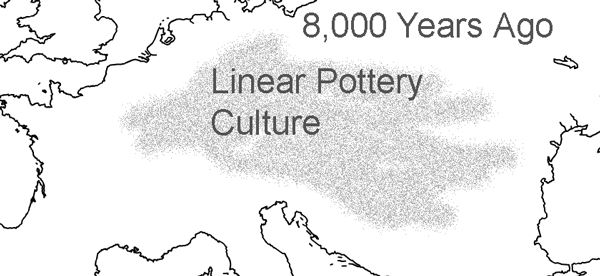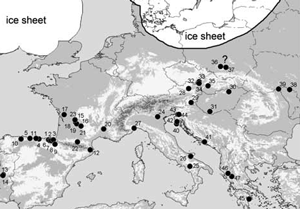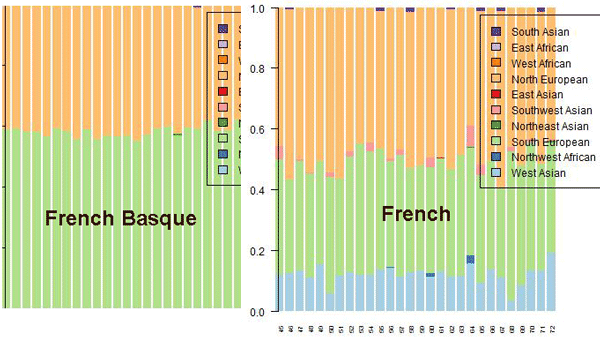European man of many faces: Cain vs. Abel
Posted on Categories Discover Magazine

When it comes to the synthesis of genetics and history we live an age of no definitive answers. L. L. Cavalli-Sforza’s Great Human Diasporas would come in for a major rewrite at this point. One of the areas which has been roiled the most within the past ten years has been the origin and propagation of the agricultural lifestyle across the European continent between 10,000-6,000 years before the present (starting in Europe’s southeast fringe a few thousand years after the origination of the Neolithic lifestyle in the Levant, and finally pushing into the southern Scandinavian peninsula only ~6,000 years ago). The reasons for this particular debate about the origin of the European are manifold. First, most scholars are of European ancestry, and some of the debates have roots going back a century. So a natural interest exists based on normal human biases. Second, when it comes to genetics the climate of Europe is ideal for the preservation and extraction of ancient DNA. Third, there are relatively clear and distinct theoretical models which can be tested by the data, whether to verify or refute.
![]() I have already reviewed earlier work in three previous posts, European man perhaps a Middle Eastern farmer, European man perhaps not a Middle Eastern farmer, and Völkerwanderung back with a vengeance. Instead of rehashing everything I’ll take it as a given that you’ve read or skimmed those posts. Rather, let’s move on to a new paper in PLoS Biology, Ancient DNA from European Early Neolithic Farmers Reveals Their Near Eastern Affinities:
I have already reviewed earlier work in three previous posts, European man perhaps a Middle Eastern farmer, European man perhaps not a Middle Eastern farmer, and Völkerwanderung back with a vengeance. Instead of rehashing everything I’ll take it as a given that you’ve read or skimmed those posts. Rather, let’s move on to a new paper in PLoS Biology, Ancient DNA from European Early Neolithic Farmers Reveals Their Near Eastern Affinities:
In Europe, the Neolithic transition (8,000–4,000 B.C.) from hunting and gathering to agricultural communities was one of the most important demographic events since the initial peopling of Europe by anatomically modern humans in the Upper Paleolithic (40,000 B.C.). However, the nature and speed of this transition is a matter of continuing scientific debate in archaeology, anthropology, and human population genetics. To date, inferences about the genetic make up of past populations have mostly been drawn from studies of modern-day Eurasian populations, but increasingly ancient DNA studies offer a direct view of the genetic past. We genetically characterized a population of the earliest farming culture in Central Europe, the Linear Pottery Culture (LBK; 5,500–4,900 calibrated B.C.) and used comprehensive phylogeographic and population genetic analyses to locate its origins within the broader Eurasian region, and to trace potential dispersal routes into Europe. We cloned and sequenced the mitochondrial hypervariable segment I and designed two powerful SNP multiplex PCR systems to generate new mitochondrial and Y-chromosomal data from 21 individuals from a complete LBK graveyard at Derenburg Meerenstieg II in Germany. These results considerably extend the available genetic dataset for the LBK (n = 42) and permit the first detailed genetic analysis of the earliest Neolithic culture in Central Europe (5,500–4,900 calibrated B.C.). We characterized the Neolithic mitochondrial DNA sequence diversity and geographical affinities of the early farmers using a large database of extant Western Eurasian populations (n = 23,394) and a wide range of population genetic analyses including shared haplotype analyses, principal component analyses, multidimensional scaling, geographic mapping of genetic distances, and Bayesian Serial Simcoal analyses. The results reveal that the LBK population shared an affinity with the modern-day Near East and Anatolia, supporting a major genetic input from this area during the advent of farming in Europe. However, the LBK population also showed unique genetic features including a clearly distinct distribution of mitochondrial haplogroup frequencies, confirming that major demographic events continued to take place in Europe after the early Neolithic.
 As I’ve indicated before the archaeological jargon is rather mystifying to me. Some of this is due to translation, the Linear Pottery Culture is abbreviated “LBK” because in the German it is Linearbandkeramik. Rather, I try and focus on some basic concrete parameters: time and space. So we have the first agricultural society with a focus on Central Europe flourishing ~7,000 years before the present. Some now we have the time and space in mind around which we can bracket all the background variables. The big question being asked, and answered, is whether the practitioners of LBK were descendants of Ice Age Europeans who expanded from the “refugia” in the south of Europe during the Last Glacial Maximum (LGM) ~20,000 years ago. To speak intelligently about these issues you need some basic intuition, so you see the map which I found on John Hawks’ weblog showing the line of settlement during the LGM. As the ice retreated presumably the European hunter-gatherers would have rapidly pushed northward, following the species which they consumed.
As I’ve indicated before the archaeological jargon is rather mystifying to me. Some of this is due to translation, the Linear Pottery Culture is abbreviated “LBK” because in the German it is Linearbandkeramik. Rather, I try and focus on some basic concrete parameters: time and space. So we have the first agricultural society with a focus on Central Europe flourishing ~7,000 years before the present. Some now we have the time and space in mind around which we can bracket all the background variables. The big question being asked, and answered, is whether the practitioners of LBK were descendants of Ice Age Europeans who expanded from the “refugia” in the south of Europe during the Last Glacial Maximum (LGM) ~20,000 years ago. To speak intelligently about these issues you need some basic intuition, so you see the map which I found on John Hawks’ weblog showing the line of settlement during the LGM. As the ice retreated presumably the European hunter-gatherers would have rapidly pushed northward, following the species which they consumed.
I’ll pass over the methodological nuts & bolts; you can find them in the paper. Obviously this isn’t technically trivial; extracting, amplifying, and avoiding contamination, from DNA samples on the order of 7,000 years old is awesome. As usual they focused on mtDNA because this is found in much larger quantities than nuclear DNA. They did get a few Y chromosomal results though, though mtDNA is the star of the show here. The mtDNA is the maternal lineage, so it can tell you only so much. Additionally, there may be selection dynamics going on to change the frequencies of some of these variants. But with those caveats in hand I think mtDNA patterns can be very informative because if women are on the move that is a pointer to a classic folk-wandering, where a whole people transplant their culture via migration. Many more British women arrived in the New World than Spanish women, and therein lay one of the crucial factors in the difference between Anglo and Latin America.
The slide show below has all the major figures of interest. I’ve also replicated the full description, and made some minor edits. Please take in the table; much of the paper really presupposes an intuitive familiarity with mtDNA haplogroup frequencies.
| mtDNA pairwise Fst by population | ||||
| Hunter-Gatherers | Near East | LBK | ||
| Near East | 4.46 | * | * | |
| LBK | 9.9 | 3.22 | * | |
| Central Europe | 3.67 | 1 | 4.22 | |
The authors also had an Fst table illustrating genetic distances using mtDNA of ancient and contemporary populations. I’ve cleaned up the table a bit, and standardized the values so that the smallest distance = 1. This is mostly so you can make immediate sense of it. What you clearly see is the enormous genetic distance between Central European hunter-gatherers and LBK, who were present in Germany right before the arrival of farmers. This comes very close to a falsification of the maximalist pots-not-people model, whereby farming spread from its point of origin in Anatolia and the Levant through a process of cultural diffusion, just like the alphabet or the potato. The relatively large distance between ancient and modern populations shouldn’t be too surprising, genetic distances operate across both time and space. There are interesting inferences one can make about the nature of gene flow over the past 10,000 years in Eurasia when viewing the relatively small distance between the two modern populations, but really the important point for the purposes of this paper is the high wall between the two cultures who practice differing modes of production.
In the paper the authors support, tentatively, a classic demic diffusion process. This is basically a very simple model whereby farmers with larger population growth rates expand into the “space” of hunter-gatherers. But as Dienekes Pontikos notes such a process would also be characterized by dilution of the original Middle Eastern “genetic signal” over time. Rather, what we see here seems to be a total transfer for a population across large distances. The authors themselves note that the LBK farmers seem to have followed the interior lines of rivers and flat-bottom plains. Farmers had discovered a new way to exploit nature, but in the end they were still ecologically constrained. The northern two-thirds of Scandinavia still had hunter-gatherer populations down to the period of the classical Greeks. This was not because of the powerful magic wielded by Väinämöinen. The Middle Eastern derived agricultural toolkit no doubt began to run into its natural ecological limits on Europe’s northern fringe. Without knowing anything further I suspect that the death of the southern Sami culture in the face of Norwegian and Swedish expansion in the early modern period was probably driven by the emergence of more systematic agricultural science, which could push the ecological limits beyond the long-standing equilibrium established in the Iron Age.
But I don’t think this is just a story of ecology. It is clearly a story of culture. We assume that culture is easily transferable from society to society. In some ways it is. The original phonetic script of Upper Mesopotamia and Syria seems to have quickly triggered imitation and appropriation from India to Italy within a few centuries of its widespread use by the Aramaeans. But farming is not like the idea of writing. The original farmers seem to have expanded rather slowly initially out of the Middle East. Not only did they perfect the biological character of their crops, they probably perfected the customs and traditions which would go along with farming. A complex suite of explicit rules and implicit norms. Perhaps it was not so easy to simply copy the farming lifestyle? Or, perhaps more interestingly, the hunter-gatherers by and large did not want to copy the farming lifestyle? (this is a tendency among some modern non-farming groups, who would rather work temporarily on farms themselves rather than become full-time obligate peasants) The large genetic distances between the LBK and the hunter-gatherers around them may indicate not only the relatively endogenous growth of the LBK in “virgin” land (e.g., compare to the Yankees of New England in the 17th and 18th century), but, also the emergence of an ideological aversion to mixing with the “savages.” We have plenty of textually attested de-humanization of the “savage” and “barbarian” by the “civilized.” It is likely that the gap between the LBK and the hunter-gatherers of Europe was only somewhat smaller than that between the Aborigines of Australia and Tasmania and the European settlers!
Finally, there’s one last issue I want to highlight: the authors find that many presumably hunter-gatherer lineages are found among the LBK, while very common haplogroups (mtDNA and Y) in Europe today are not found among the LBK or the ancient hunter-gatherers. The clear inference then would be that Europe went through several periods of demographic change and migration within the last 10,000 years. A simple two-way admixture scenario will not suffice. Yesterday I posted this bar plot which contrasted the pattern of ancestry of French vs. French Basque using ADMIXTURE at K = 10:

The green element is nearly 100% in Sardinia, and drops off to nearly nothing somewhere around Iran. The light blue component is modal around the Caucasus, though is widely distributed, from Spain to Bengal (yeah, that’s me!) to Sweden. A simple model would be that the light blue arrived with Neolithic agriculturalists, as the Basques are the descendants of the original Ice Age Europeans. But this may not be correct, and our impression of the Basques may be totally false. It is not out of the question now that the Basque culture may have arrived via the ancient leap-frogging of agriculture from fertile regions around the Mediterranean before the seafarers passed into the Atlantic and swept around the western fringe of Iberia. What we may be seeing is a palimpsest of agriculturalists, where the Basques simply lack the last layer.
In any case, one can speculate a lot right. Ancient DNA has allowed us to refute maximalist versions of pots-not-people, but has also overturned our ability to hold to simple robust models. In science you prefer parsimony, unless parsimony simply can’t explain the patterns at hand. I think we’re there at this point.
Citation: Wolfgang Haak, Oleg Balanovsky, Juan J. Sanchez, Sergey Koshel, Valery Zaporozhchenko, Christina J. Adler, Clio S. I. Der Sarkissian, Guido Brandt, Carolin Schwarz, Nicole Nicklisch, Veit Dresely, Barbara Fritsch, Elena Balanovska, Richard Villems, Harald Meller, Kurt W. Alt, Alan Cooper, & Genographic Consortium (2010). Ancient DNA from European Early Neolithic Farmers Reveals Their Near Eastern Affinities PLoS Biology : 10.1371/journal.pbio.1000536



